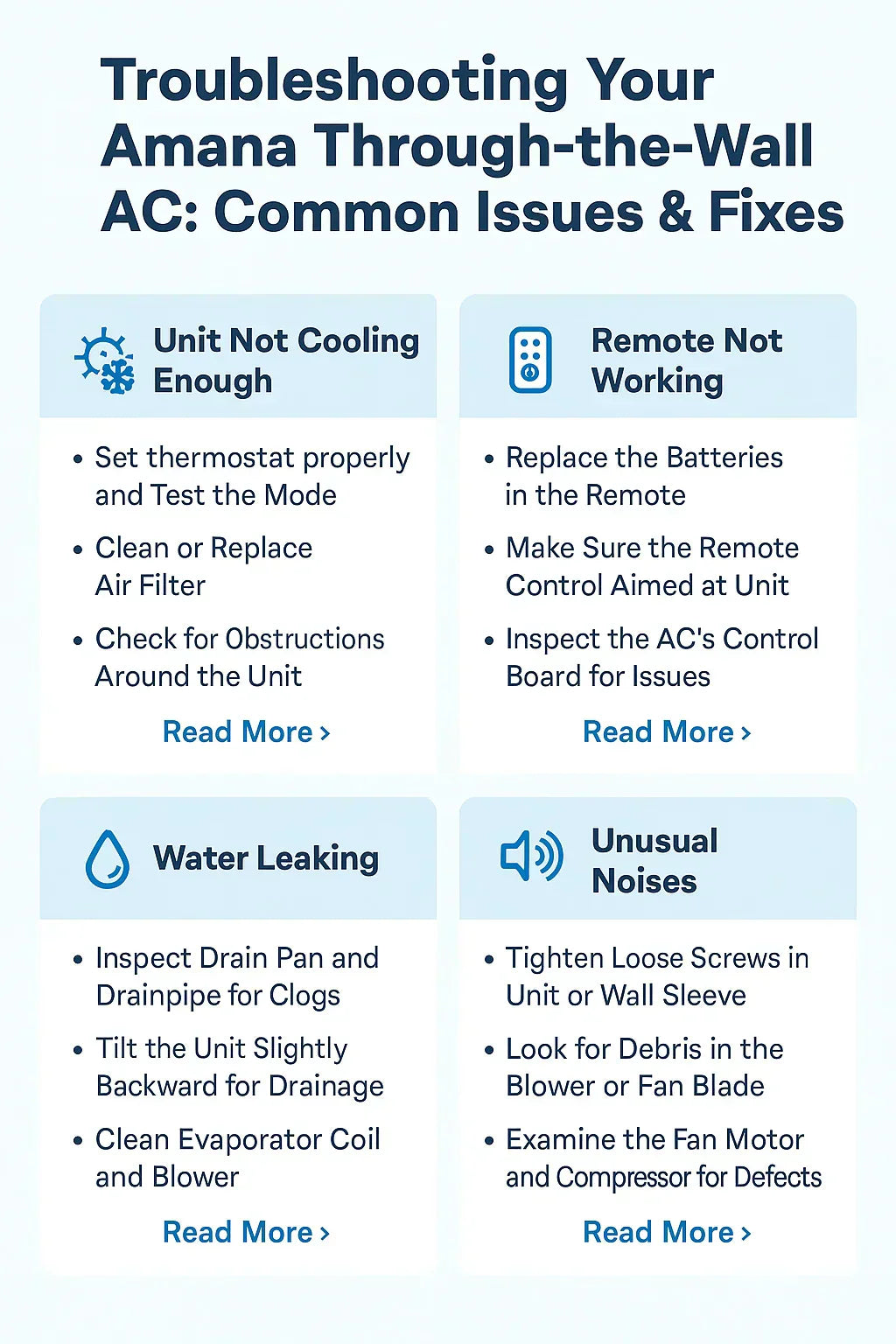Even reliable units like the Amana 9,300 BTU Through-the-Wall AC (PBC093J00AA) can encounter issues, especially after years of seasonal operation. Understanding common problems, their causes, and practical fixes will save you time, prevent costly repairs, and keep your space comfortable.
This comprehensive guide will cover:
✅ Common symptoms and what they mean.
✅ Step-by-step diagnostic checks.
✅ DIY solutions for minor issues.
✅ When to call a professional.
✅ Preventative maintenance tips to reduce future issues.
❄️ 1. Unit Not Cooling Properly
Possible Causes:
-
Dirty air filter or coils.
-
Thermostat set incorrectly.
-
Blocked condenser or evaporator coils.
-
Low refrigerant (requires professional service).
-
Incorrect mode settings (e.g., fan instead of cool).
What You Can Do:
✅ Check and clean or replace the air filter following Amana’s maintenance instructions.
✅ Ensure the thermostat is set to "Cool" and desired temperature is lower than room temperature.
✅ Clear debris around the exterior of the unit.
✅ Verify windows and doors are closed while the unit is operating.
If cleaning does not restore cooling, contact a licensed HVAC technician to inspect refrigerant levels.
🔇 2. Unusual Noises During Operation
Possible Causes:
-
Loose parts or mounting hardware.
-
Fan obstruction by debris or ice buildup.
-
Worn-out fan motor or bearings.
What You Can Do:
✅ Turn off the unit and inspect for visible obstructions in the fan area.
✅ Check mounting screws and brackets for tightness.
✅ Clean filters to prevent overworking the fan motor.
✅ If the noise persists, contact a professional for motor inspection.
Read Consumer Reports on AC noise issues for further guidance.
💧 3. Water Leaking Inside the Room
Possible Causes:
-
Clogged drain channels or pan.
-
Unit not tilted correctly for drainage.
-
Excess humidity overwhelming the drain system.
What You Can Do:
✅ Ensure the unit is installed with a slight backward tilt (1/4 inch) for drainage.
✅ Clean drain holes with a soft brush or compressed air.
✅ Inspect the drain pan for cracks or blockages.
✅ Use "Dry" or "Dehumidify" mode in humid conditions.
For managing indoor humidity, see the EPA’s humidity control guide.
⚡ 4. Unit Not Powering On
Possible Causes:
-
Tripped circuit breaker.
-
Faulty power cord or plug.
-
GFCI outlet tripped.
-
Internal electrical failure.
What You Can Do:
✅ Check your home’s breaker panel for tripped breakers.
✅ Test the outlet with another appliance to confirm power.
✅ Press the "Reset" button on the GFCI outlet.
✅ Inspect the power cord for visible damage.
If the unit still does not power on, contact a professional electrician or HVAC technician.
For electrical safety, review NFPA electrical guidelines.
🌬️ 5. Weak Airflow
Possible Causes:
-
Dirty air filter or coils.
-
Blocked vents or obstructions in airflow path.
-
Fan motor issues.
-
Incorrect fan speed settings.
What You Can Do:
✅ Clean or replace the air filter.
✅ Check and clear any obstructions around the unit.
✅ Adjust fan speed settings.
✅ Inspect the rear of the unit for external obstructions.
See the Department of Energy’s AC efficiency tips to maintain effective airflow and cooling.
🌡️ 6. Unit Cycles On and Off Frequently (Short Cycling)
Possible Causes:
-
Unit oversized for the room.
-
Dirty filters causing overheating.
-
Thermostat issues.
What You Can Do:
✅ Ensure filters and coils are clean.
✅ Place the thermostat away from heat sources.
✅ Verify the unit is not too large for your space using the Energy Star AC sizing guide.
If the issue persists, a professional may need to inspect the thermostat or control board.
🔧 Preventative Maintenance to Avoid Future Issues
Routine maintenance reduces repair needs and extends unit lifespan: ✅ Clean filters monthly during heavy use.
✅ Inspect and clean coils seasonally.
✅ Check drainage systems and rear grilles.
✅ Ensure the unit is installed with the correct tilt.
✅ Keep the area around the unit clear of obstructions.
Learn about seasonal maintenance with Energy Star’s guide.
🛡️ When to Call a Professional
Contact an HVAC professional if:
-
Refrigerant leaks are suspected.
-
Persistent electrical issues occur.
-
Fan or compressor makes grinding or squealing noises.
-
Unit fails to cool despite all troubleshooting.
🧩 FAQs on Troubleshooting Amana Through-the-Wall ACs
Can I recharge my Amana AC myself?
No. Refrigerant handling requires EPA certification and should only be performed by licensed technicians.
How often should I clean the filter?
Monthly during peak season or more frequently in dusty environments.
My remote isn’t working. What should I do?
Check and replace the batteries, ensure there is a clear line of sight to the unit, and inspect the remote for damage.
🏠 Real User Tips for Maintaining Performance
✅ Use blackout curtains to reduce heat load.
✅ Seal doors and windows to minimize heat infiltration.
✅ Use ceiling fans to enhance cool air circulation.
✅ Turn off the AC when not needed or use "Eco Mode."
For optimizing your system, see Energy Saver’s home cooling strategies.
🎯 Conclusion: Keep Your Amana AC Running Smoothly
- Your Amana through-the-wall AC is designed for durability, but regular maintenance and timely troubleshooting are essential to ensure consistent, efficient cooling.
By following this guide:
✅ You can solve many common issues without service calls.
✅ Extend your unit's lifespan.
✅ Maintain energy-efficient, reliable operation.
📌 Next Steps
✅ Bookmark this guide for future reference.
✅ Perform routine maintenance to avoid common issues.
✅ Contact a professional for persistent or complex problems.
✅ Consider upgrading to an ENERGY STAR model for added efficiency.
For additional information, check Amana's support resources.
In the next topic we will know more about: Energy Efficiency Tips for Your Through-the-Wall AC







